Mutual Coupling Reduction in MIMO DRA through Metamaterials
Abstract
:1. Introduction
2. Design of Proposed MIMO DRA
3. Evaluation of Proposed Design
SRR Configuration
4. Parametric Analysis
5. Simulated and Measured Results
5.1. Experimental Results
5.2. Reflection Coefficients
5.3. Simulated and Measured Gain
5.4. Surface Current Distribution
5.5. Far Field Radiation Characteristics
6. MIMO Parameters
6.1. Envelop Correlation Coefficient
6.2. Diversity Gain (DG)
6.3. Channel Capacity Loss (CCL)
6.4. Mean Effective Gain (MEG)
6.5. Total Active Reflection Coefficient (TARC)
7. Conclusions
Author Contributions
Funding
Institutional Review Board Statement
Informed Consent Statement
Data Availability Statement
Conflicts of Interest
References
- Capolino, F. Applications of Metamaterials; CRC Press: Boca Raton, FL, USA, 2017. [Google Scholar]
- Eleftheriades, G.V.; Balmain, K.G. Negative-Refraction Metamaterials: Fundamental Principles and Applications; John Wiley & Sons: Hoboken, NJ, USA, 2005. [Google Scholar]
- Salicrú Cortés, M. Study of Performance of Reference MIMO Antenna Configurations using Experimental Propagation Data. Master’s Thesis, Universitat Politècnica de Catalunya, Barcelona, Spain, 2009. [Google Scholar]
- Abdullah, S.; Xiao, G.; Amaya, R.E. A review on the history and current literature of metamaterials and its applications to antennas & radio frequency identification (RFID) devices. IEEE J. Radio Freq. Identif. 2021, 5, 427–445. [Google Scholar]
- Saadh, A.M.; Ashwath, K.; Ramaswamy, P.; Ali, T.; Anguera, J. A uniquely shaped MIMO antenna on FR4 material to enhance isolation and bandwidth for wireless applications. AEU-Int. J. Electron. Commun. 2020, 123, 153316. [Google Scholar] [CrossRef]
- Kulkarni, J.; Alharbi, A.G.; Elfergani, I.; Anguera, J.; Zebiri, C.; Rodriguez, J. Dual polarized, multiband four-port decagon shaped flexible MIMO antenna for next generation wireless applications. IEEE Access 2022, 10, 128132–128150. [Google Scholar] [CrossRef]
- Nej, S.; Ghosh, A.; Ahmad, S.; Ghaffar, A.; Hussein, M. Compact quad band MIMO antenna design with enhanced gain for wireless communications. Sensors 2022, 22, 7143. [Google Scholar] [CrossRef]
- Yang, F.; Rahmat-Samii, Y. Microstrip antennas integrated with electromagnetic band-gap (EBG) structures: A low mutual coupling design for array applications. IEEE Trans. Antennas Propag. 2003, 51, 2936–2946. [Google Scholar] [CrossRef]
- Ghosh, S.; Tran, T.N.; Le-Ngoc, T. Dual-layer EBG-based miniaturized multi-element antenna for MIMO systems. IEEE Trans. Antennas Propag. 2014, 62, 3985–3997. [Google Scholar] [CrossRef]
- Xin, H.; Matsugatani, K.; Kim, M.; Hacker, J.; Higgins, J.A.; Rosker, M.; Tanaka, M. Mutual coupling reduction of low-profile monopole antennas on high-impedance ground plane. Electron. Lett. 2002, 38, 849–850. [Google Scholar] [CrossRef]
- Gheethan, A.A.; Herzig, P.A.; Mumcu, G. Compact 2 × 2 coupled double loop GPS antenna array loaded with broadside coupled split ring resonators. IEEE Trans. Antennas Propag. 2013, 61, 3000–3008. [Google Scholar] [CrossRef]
- Qamar, Z.; Riaz, L.; Chongcheawchamnan, M.; Khan, S.A.; Shafique, M.F. Slot combined complementary split ring resonators for mutual coupling suppression in microstrip phased arrays. IET Microw. Antennas Propag. 2014, 8, 1261–1267. [Google Scholar] [CrossRef]
- Bait-Suwailam, M.M.; Boybay, M.S.; Ramahi, O.M. Electromagnetic coupling reduction in high-profile monopole antennas using single-negative magnetic metamaterials for MIMO applications. IEEE Trans. Antennas Propag. 2010, 58, 2894–2902. [Google Scholar] [CrossRef]
- Wiltshire MC, K.; Hajnal, J.V.; Pendry, J.B.; Edwards, D.J.; Stevens, C.J. Metamaterial endoscope for magnetic field transfer: Near field imaging with magnetic wires. Opt. Express 2003, 11, 709–715. [Google Scholar] [CrossRef] [PubMed]
- Roshna, T.K.; Deepak, U.; Sajitha, V.R.; Vasudevan, K.; Mohanan, P. A compact UWB MIMO antenna with reflector to enhance isolation. IEEE Trans. Antennas Propag. 2015, 63, 1873–1877. [Google Scholar] [CrossRef]
- Yeom, I.; Kim, H.; Jung, J.; Jung, C.W. Analysis of spatial/polarization diversity using a broadband slot-coupled patch antenna for the WLAN 802.11 A/B/G/N access point. Microw. Opt. Technol. Lett. 2015, 57, 1042–1048. [Google Scholar] [CrossRef]
- Baena, J.D.; Marqués, R.; Medina, F.; Martel, J. Artificial magnetic metamaterial design by using spiral resonators. Phys. Rev. B 2004, 69, 014402. [Google Scholar] [CrossRef]
- Selvaraju, R.; Jamaluddin, M.H.; Kamarudin, M.R.; Nasir, J.; Dahri, M.H. Complementary split ring resonator for isolation enhancement in 5G communication antenna array. Prog. Electromagn. Res. C 2018, 83, 217–228. [Google Scholar] [CrossRef]
- Shamonin, M.; Shamonina, E.; Kalinin, V.; Solymar, L. Properties of a metamaterial element: Analytical solutions and numerical simulations for a singly split double ring. J. Appl. Phys. 2004, 95, 3778–3784. [Google Scholar] [CrossRef]
- Sauviac, B.; Simovski, C.R.; Tretyakov, S.A. Double split-ring resonators: Analytical modeling and numerical simulations. Electromagnetics 2004, 24, 317–338. [Google Scholar] [CrossRef]
- Chen, L.; Ma, Q.; Luo, S.S.; Ye, F.J.; Cui, H.Y.; Cui, T.J. Touch-Programmable Metasurface for Various Electromagnetic Manipulations and Encryptions. Small 2022, 18, 2203871. [Google Scholar] [CrossRef]
- Ma, Q.; Gao, W.; Xiao, Q.; Ding, L.; Gao, T.; Zhou, Y.; Gao, X.; Yan, T.; Liu, C.; Gu, Z.; et al. Directly wireless communication of human minds via non-invasive brain-computer-metasurface platform. Elight 2022, 2, 11. [Google Scholar] [CrossRef]
- Trivedi, K.; Pujara, D. Suppression of mutual coupling in wideband tree shaped fractal DRA array for MIMO applications. In Proceedings of the 2017 11th European Conference on Antennas and Propagation (EUCAP), Paris, France, 19–24 March 2017; IEEE: New York, NY, USA, 2017; pp. 2209–2211. [Google Scholar]
- Sahu, N.K.; Gangwar, R.K.; Kumari, P. Dielectric resonator based circularly polarized MIMO antenna for WLAN applications. In Proceedings of the 2018 3rd International Conference on Microwave and Photonics (ICMAP), Dhanbad, India, 9–11 February 2018; IEEE: New York, NY, USA, 2018; pp. 1–2. [Google Scholar]
- Das, G.; Sharma, A.; Gangwar, R.K.; Sharawi, M.S. Compact back-to-back DRA-based four-port MIMO antenna system with bi-directional diversity. Electron. Lett. 2018, 54, 884–886. [Google Scholar] [CrossRef]
- Zou, L.; Abbott, D.; Fumeaux, C. Omnidirectional cylindrical dielectric resonator antenna with dual polarization. IEEE Antennas Wirel. Propag. Lett. 2012, 11, 515–518. [Google Scholar] [CrossRef]
- Das, G.; Sharma, A.; Gangwar, R.K. Dual port aperture coupled MIMO cylindrical dielectric resonator antenna with high isolation for WiMAX application. Int. J. RF Microw. Comput.-Aided Eng. 2017, 27, e21107. [Google Scholar] [CrossRef]
- Sharawi, M.S.; Podilchak, S.K.; Khan, M.U.; Antar, Y.M. Dual-frequency DRA-based MIMO antenna system for wireless access points. IET Microw. Antennas Propag. 2017, 11, 1174–1182. [Google Scholar] [CrossRef]
- Abdalrazik, A.; Abd El-Hameed, A.S.; Abdel-Rahman, A.B. A three-port MIMO dielectric resonator antenna using decoupled modes. IEEE Antennas Wirel. Propag. Lett. 2017, 16, 3104–3107. [Google Scholar] [CrossRef]
- Sharma, A.; Das, G.; Gangwar, R.K. Dual polarized triple band hybrid MIMO cylindrical dielectric resonator antenna for LTE2500/WLAN/WiMAX applications. Int. J. RF Microw. Comput. -Aided Eng. 2016, 26, 763–772. [Google Scholar] [CrossRef]
- Sahu, N.K.; Das, G.; Gangwar, R.K. L-shaped dielectric resonator based circularly polarized multi-input-multi-output (MIMO) antenna for wireless local area network (WLAN) applications. Int. J. RF Microw. Comput.-Aided Eng. 2018, 28, e21426. [Google Scholar] [CrossRef]
- Chen, H.N.; Song, J.M.; Park, J.D. A compact circularly polarized MIMO dielectric resonator antenna over electromagnetic band-gap surface for 5G applications. IEEE Access 2019, 7, 140889–140898. [Google Scholar] [CrossRef]
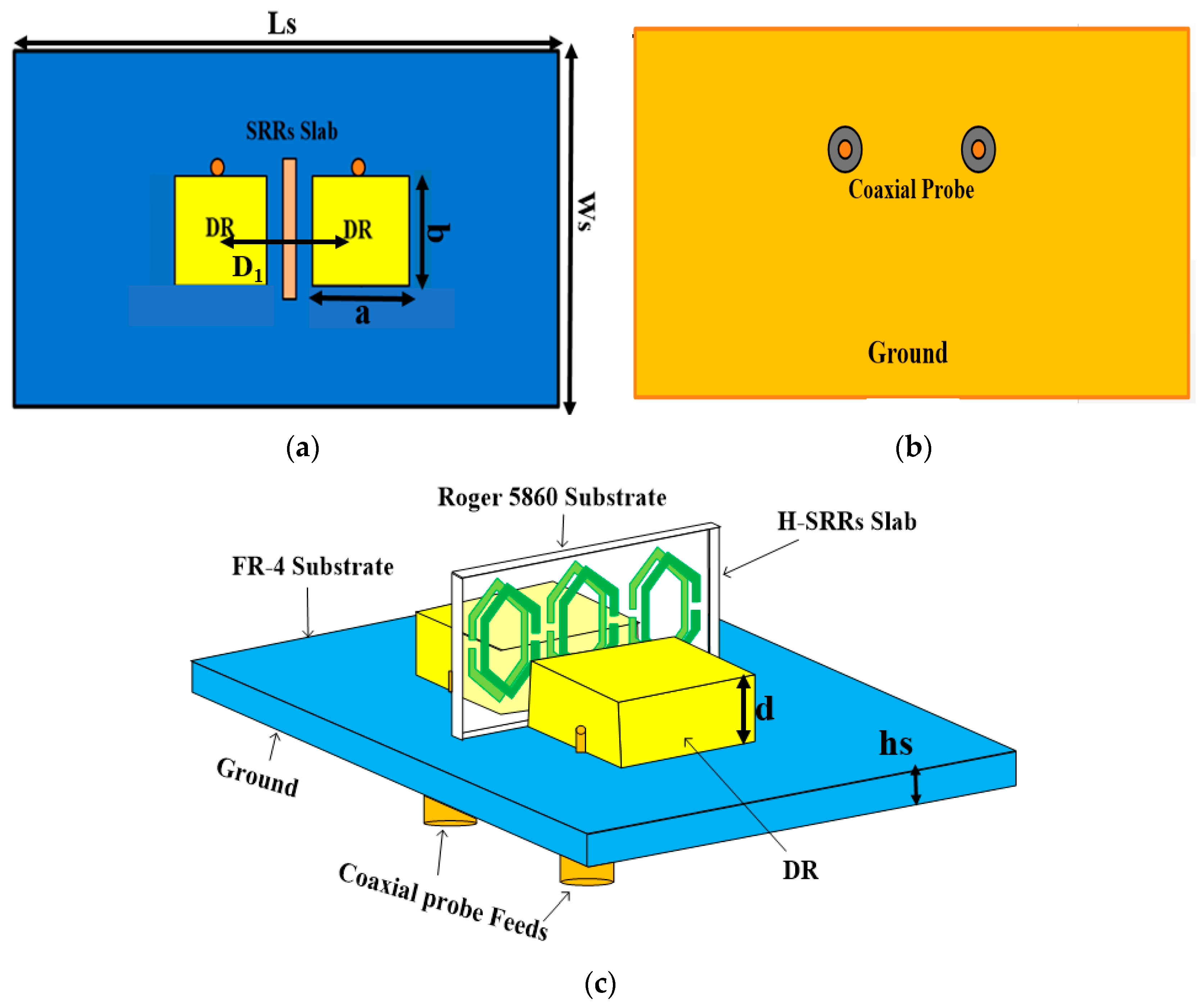



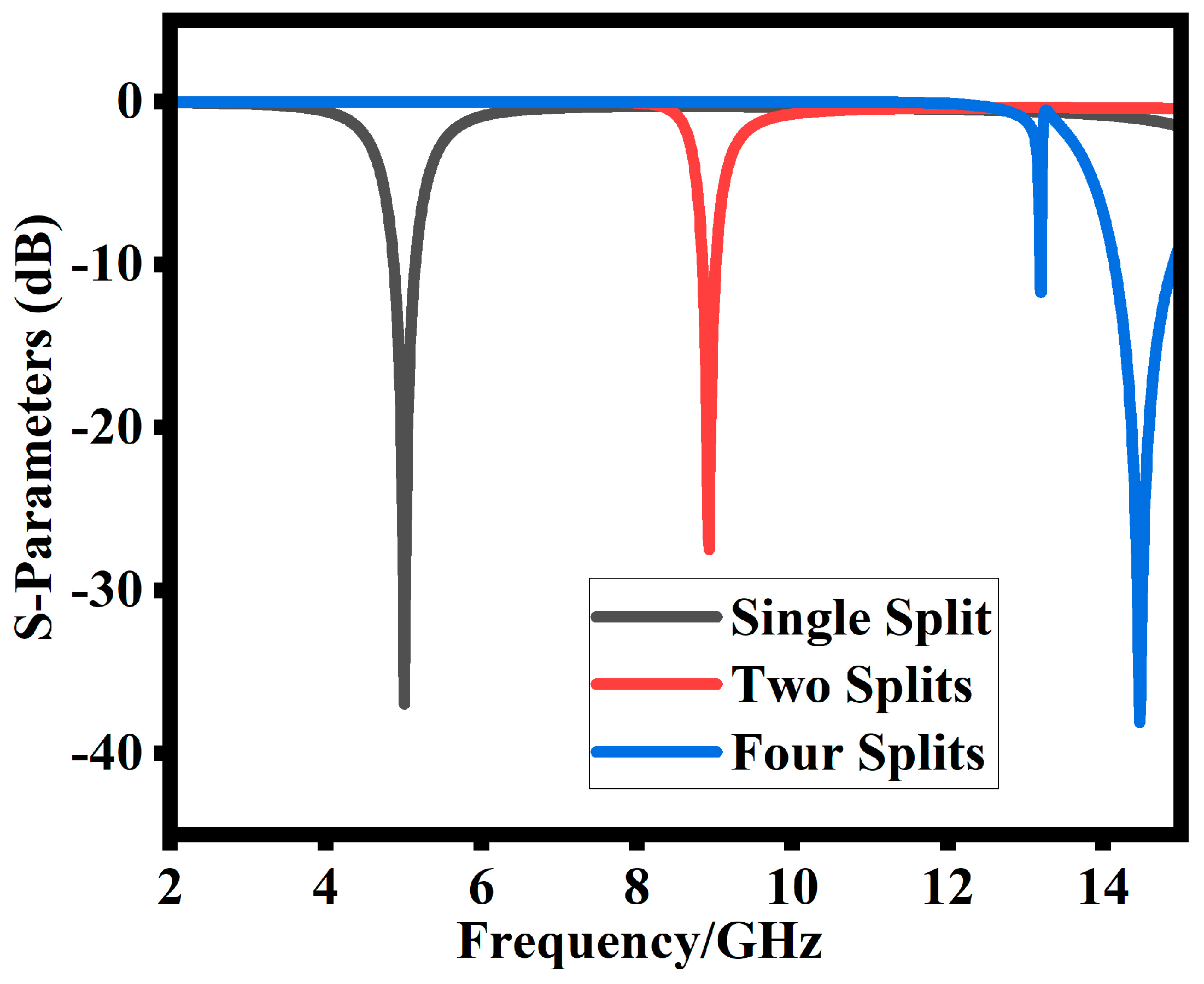
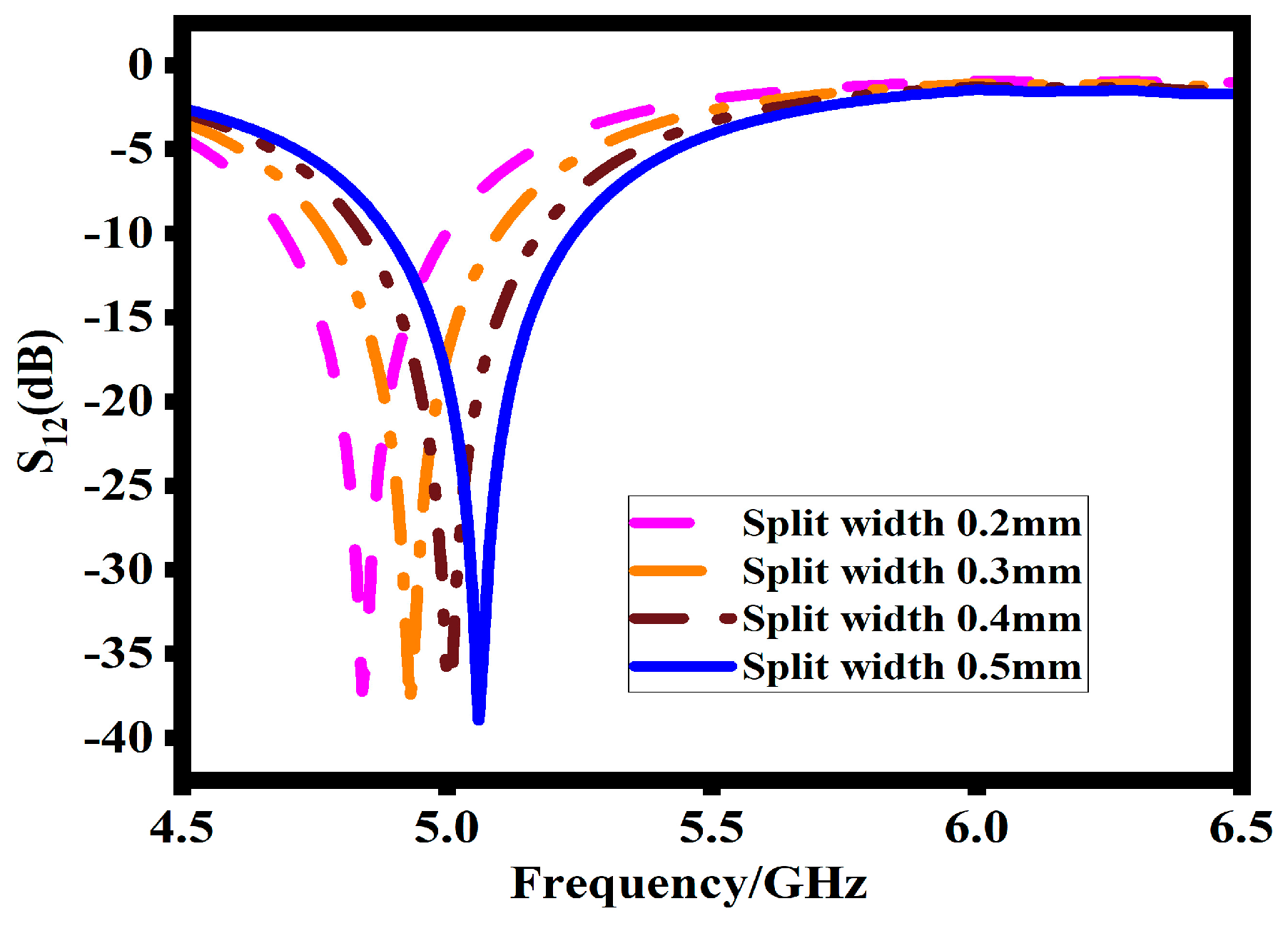
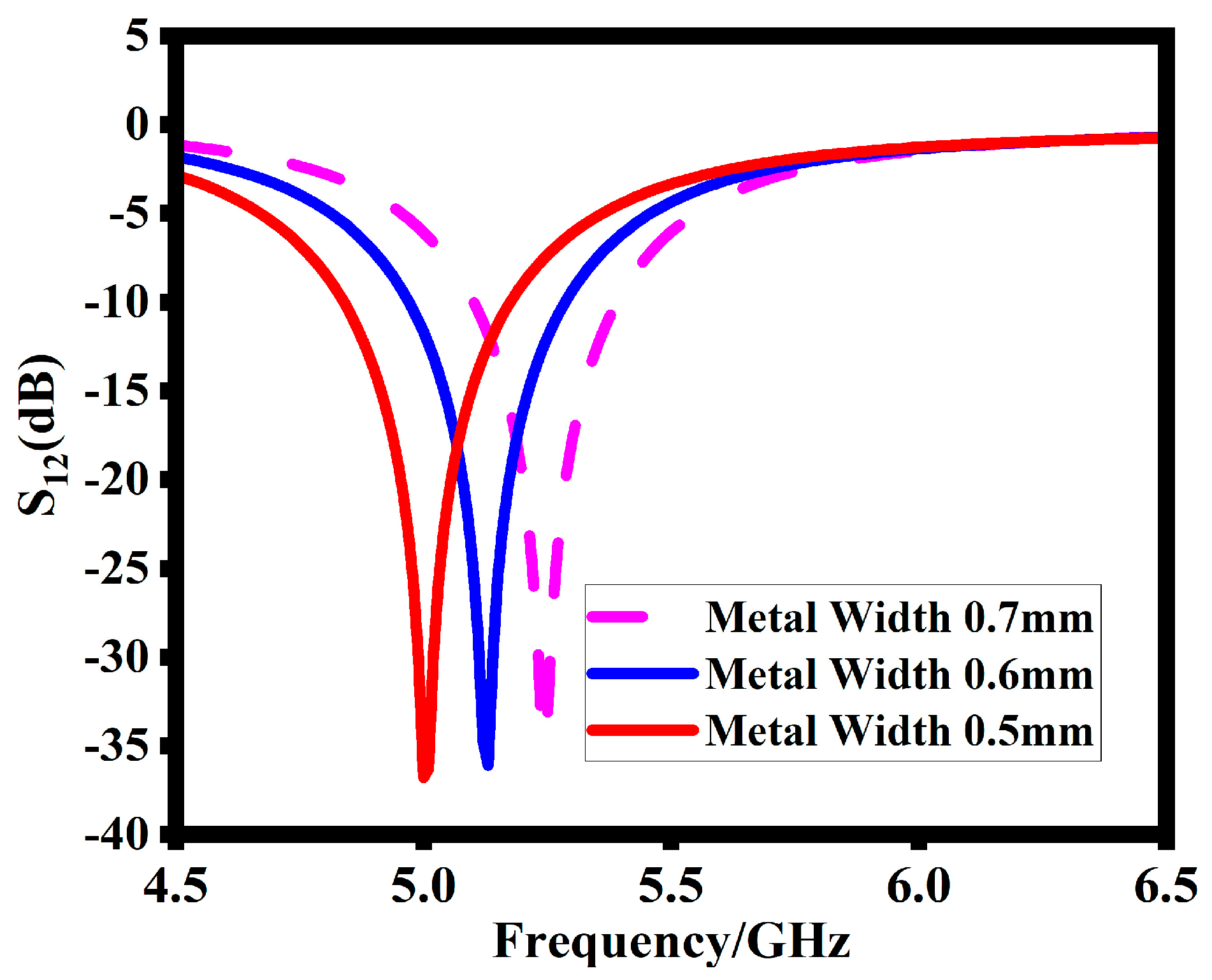

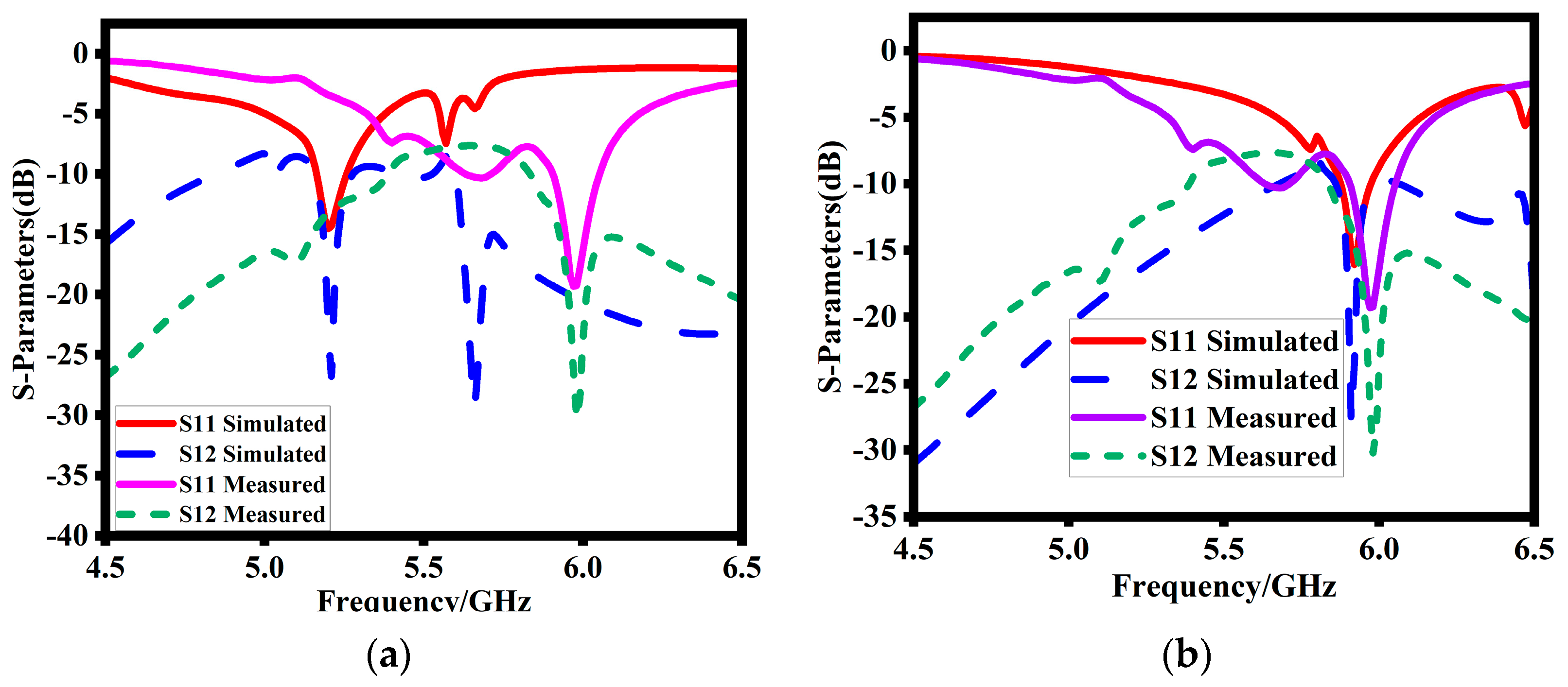





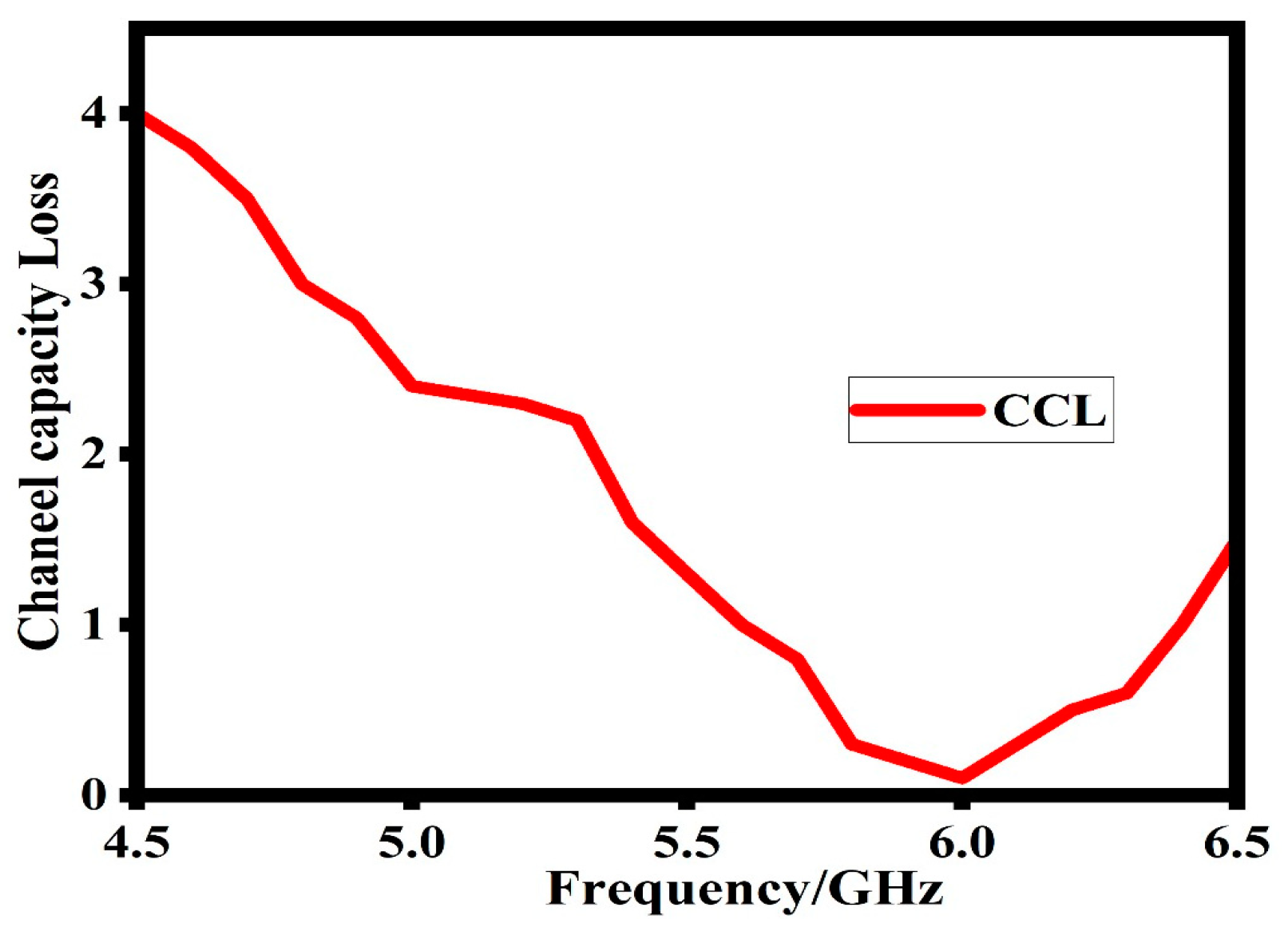
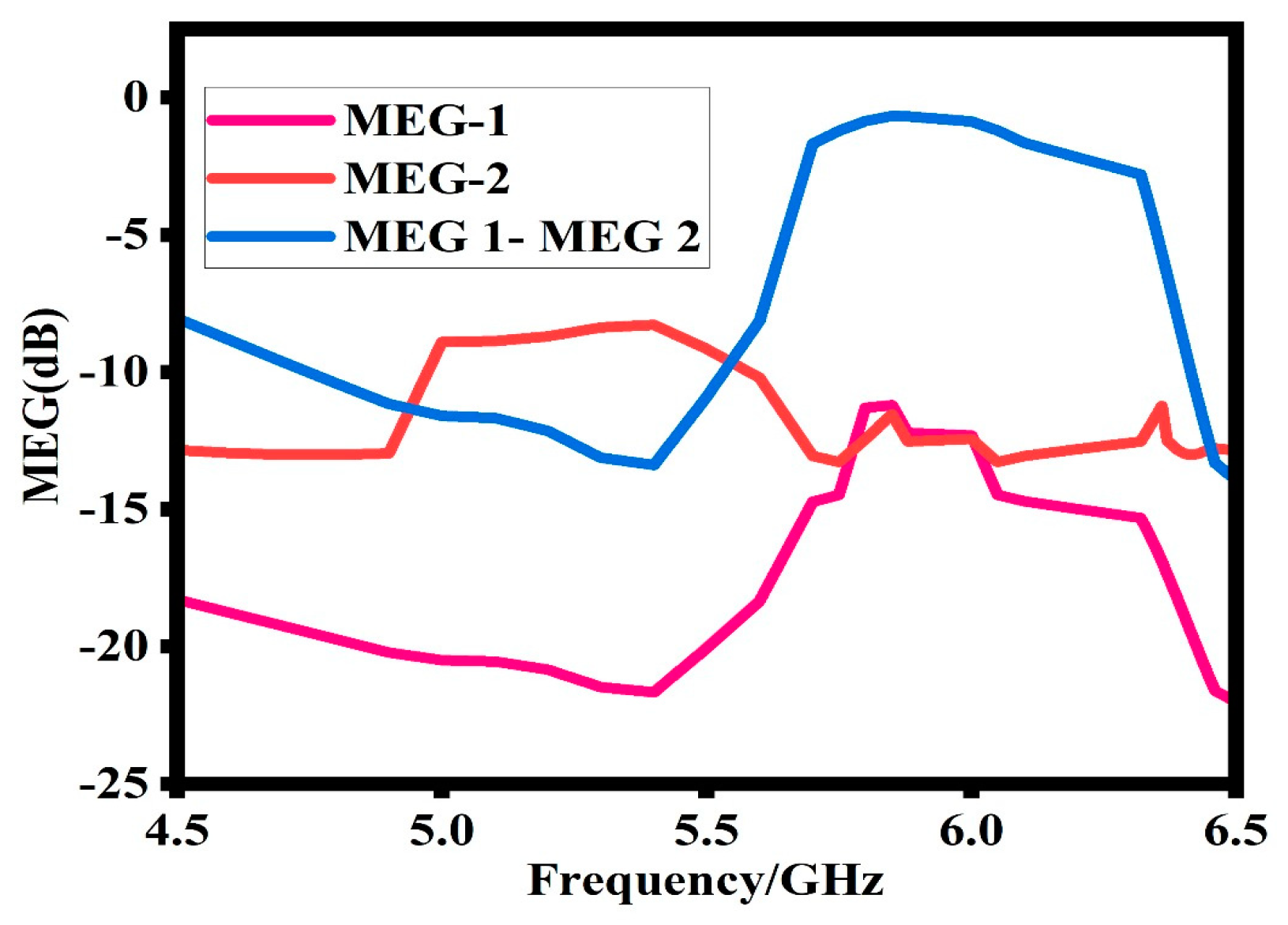

| Parameters | Dimensions (mm) | Parameters | Dimensions (mm) |
|---|---|---|---|
| A, b | 13 | Ls | 40 |
| d | 3.15 | hs | 1.6 |
| Ws | 58.3 | D1 | λ/4 |
| R, g | 3.9, 0.5 | c | 0.6 |
| Ref. | Dimension (mm2) /λg2 | Type of Antenna | Gain (dBi) | Isolation (dB) |
|---|---|---|---|---|
| [23] | 60 × 60 × 10.054 (0.8λ × 0.8λ × 0.13λ) | Fractal DRA | Not mentioned | ~15 |
| [25] | 30 × 30 × 8.1 (1.85λ × 1.85λ × 0.145λ) | Printed | 5 | 18 |
| [26] | 100 × 100 × 8.14 (0.79λ × 0.79λ × 0.1) | CDRA | 2.1 | 20 |
| [27] | 50 × 50 × 14.6 (1.93λ × 1.93λ × 0.15λ) | CDRA | Not mentioned | 25 |
| [28] | 160 × 160 × 14 (3.1λ × 3.1λ × 0.14λ) | CDRA | Not mentioned | 15 |
| [29] | 56.6 × 31.5 × 14.09 (1.69λ × 0.94λ × 0.27λ) | RDRA | Not mentioned | 20 |
| [30] | 78 × 50 × 6.4 (1.71λ × 2.67λ × 0.057λ) | CDRA | 2.3 | 20 |
| [24] | 70 × 60x9.1 (1.12λ × 0.96λ × 0.14λ) | RDRA | Not mentioned | 12 |
| [31] | 40 × 65 × 7.6 (1.44λ × 0.88λ) | RDRA | 4 | 19 |
| [32] | 46 × 46 × 21.6 (2.17λ × 2.17λ × 0.216) | RDRA | Not mentioned | 24 |
| Proposed | 40 × 58.3 × 4.75 (1.5λ × 1.02λ × 0.079) | RDRA | 5 | 30 |
Disclaimer/Publisher’s Note: The statements, opinions and data contained in all publications are solely those of the individual author(s) and contributor(s) and not of MDPI and/or the editor(s). MDPI and/or the editor(s) disclaim responsibility for any injury to people or property resulting from any ideas, methods, instructions or products referred to in the content. |
© 2023 by the authors. Licensee MDPI, Basel, Switzerland. This article is an open access article distributed under the terms and conditions of the Creative Commons Attribution (CC BY) license (https://creativecommons.org/licenses/by/4.0/).
Share and Cite
Khan, M.S.; Khan, S.; Khan, O.; Aqeel, S.; Gohar, N.; Dalarsson, M. Mutual Coupling Reduction in MIMO DRA through Metamaterials. Sensors 2023, 23, 7720. https://doi.org/10.3390/s23187720
Khan MS, Khan S, Khan O, Aqeel S, Gohar N, Dalarsson M. Mutual Coupling Reduction in MIMO DRA through Metamaterials. Sensors. 2023; 23(18):7720. https://doi.org/10.3390/s23187720
Chicago/Turabian StyleKhan, Muhammad Sabir, Shahid Khan, Owais Khan, Sajid Aqeel, Neelam Gohar, and Mariana Dalarsson. 2023. "Mutual Coupling Reduction in MIMO DRA through Metamaterials" Sensors 23, no. 18: 7720. https://doi.org/10.3390/s23187720





